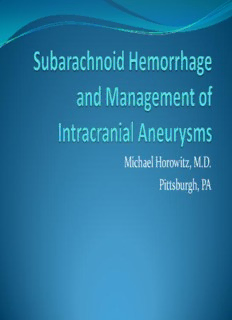
Subarachnoid Hemorrhage and Management of Intracranial Aneurysms PDF
Preview Subarachnoid Hemorrhage and Management of Intracranial Aneurysms
Michael Horowitz, M.D. Pittsburgh, PA Skull and Intracranial Compartments Scalp Subgaleal Space Bone (Calvarium) Epidural Space Dura Mater Subdural Space Arachnoid Subarachnoid Space Pia Mater Brain Parenchyma Ventricles Normal Vasculature with Aneurysm Subarachnoid Space Contains larger cerebral blood vessels prior to arterial branches penetrating the brain parenchyma through Virchow Robin spaces Contains cerebrospinal fluid (CSF) WHEN BLOOD VESSELS TEAR OR RUPTURE THEY GENERALLY RELEASE BLOOD INTO THE SUBARACHNOID SPACE WHERE IT MIXES WITH CSF. OCCASIONALLY THIS BLOOD CAN EXTEND INTO THE BRAIN PARENCHYMA (20-40% INCIDENCE), INTRAVENTRICULAR SPACE (13-28% INCIDENCE, AND SUBDURAL SPACE (2-5% INCIDENCE) DEPENDING UPON THE ANEURYSM’S LOCATION Etiology of SAH Trauma (most common cause of SAH) Spontaneous SAH Aneurysms 75-80% Congenital Traumatic Mycotic (Infectious) Flow related Dissecting Arteriovenous Malformations (AVMS; usually secondary to rupture of an associated aneurysm or dilated vein) 4-5% Vasculopathy/Vasculitis Intracranial arterial dissection (hemorrhage into the wall of a blood vessel) and subsequent extension through the wall and into the SA space Rupture of small intracranial vessel Coagulopathy Spinal AVM Drugs (Cocaine, amphetamine) Sickle cell disease Pituitary apoplexy (hemorrhage into the pituitary gland secondary to tumor infarction) Benign perimesencephalic hemorrhage Unknown etiology (14-22%) Aneurysm Definition/Description A cerebral aneurysm is a dilatation of an intracranial artery. Saccular a. (berry) more common than fusiform a. Saccular a. are generally located at a point where the artery divides into two branches Fusiform a. are generally located along the long axis of the artery Saccular a. have a neck (opening) and a fundus (sac) Aneurysm size refers to the diameter of the fundus measured in mm. (usually measured as longest length across the fundus) Fundus:Neck (F:N) ratio is often measured Giant aneurysm (>25mm) Often present secondary to mass effect (pressure on the brain) and neurologic deficit Wide neck aneurysm defined as F:N <2 or neck greater than 4 mm in diameter Aneurysm Images (Mycotic) Aneurysm (Traumatic GSW) Basilar Aneurysm (Saccular) Aneurysm Biology What causes aneurysms to develop? Intracranial arteries are relatively fragile with less muscle, elastic protein, and thinner walls that peripheral arteries of similar size The intracranial arteries have less supporting tissue surrounding them than peripheral arteries Aneurysms most often form at bifurcations where there is turbulent flow and stress Congenital defects in the media layer of the artery may exist in some individuals Infection and subsequent inflammation and weakening of the arterial wall Traumatic destruction of the arterial wall Spontaneous hemorrhage into the arterial wall with subsequent aneurysm formation
Description: